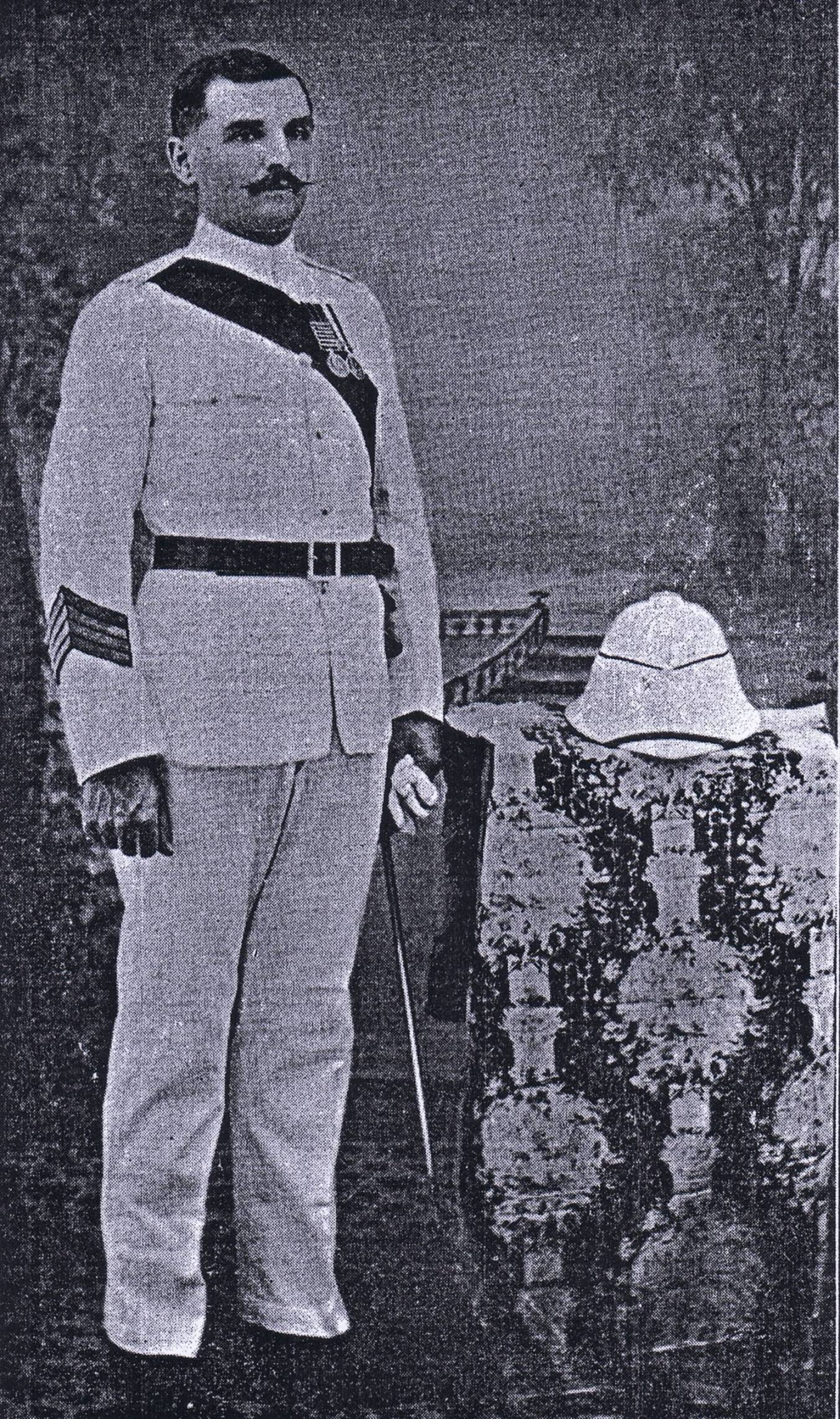
Researched by John Mills.
Born 27th of January 1880 Thomas was the son of Sergeant Valentine Goode also of the Yorkshire Regiment and his mother was called Helen. He was part of a large family; he had five brothers and two sisters.
He enlisted in Richmond on the 27th of August 1897. Being a first rate rifle shot he devoted himself to musketry and became an instructor. He served throughout the whole of the Boer War with the 1st Battalion. He was awarded the Queen’s medal with 6 clasps and the King’s with 2.
In 1905 he married Mary Agnes Grace Dobinson.
In 1914 he was with the 1st Battalion in India, his campaign medals indicate he was in France some time after 1915. He became a 2nd lieutenant in the Somerset Light Infantry (Prince Albert’s). He survived the war and retired with the rank of Captain on the 8th of June 1920.
He was awarded the M.B.E. on the 3rd of June 1919 for his services in connection with the war in India.
He must have returned to the army to serve in World War 2 because he has campaign medals (World War 2 service medal and war medal). Perhaps this might have been in some form of instructor role.
Explore more memories from the ribbon
-
Herbert Read DSO, MC
Herbert Read served in the 2nd, 7th and 10th battalions of the Yorkshire Regiment from 1915 to 1918. During his time in service he was awarded the Military Cross for his actions in leading a trench raid, successfully securing a German prisoner for interrogation and a Distinguished Service Order for his role commanding the 2nd Battalion during the German Spring Offensive of March 1918. He published two volumes of war poetry during the conflict and is commemorated alongside Wilfred Owen and Siegfried Sassoon in Poets’ Corner in Westminster Abbey. He became a leading figure in the 20th Century, as curator at the Victoria and Albert Museum and Professor of Art at Edinburgh and Harvard Universities. He counted Picasso, Dali, Graham Greene, George Orwell, Peggy Guggenheim and Man Ray amongst his friends. A knighthood in 1953 (at the suggestion of Winston Churchill) came as a surprise to his circle of political associates. His headstone at St Gregory’s Minster near Helmsley reads ‘Knight, Poet, Anarchist’.
-
Captain Amis
Submitted by Robert Amis. Captain Henry Amis (Robert’s grandfather) was commissioned into the 5th Battalion of the Yorkshire Regiment as a 2nd Lieutenant on 12 March 1915, Henry Amis transferred to the Royal Flying Corps. Family legend has it that 2Lt Amis was prone to crashing, which may account for his transfer back to the Yorkshire Regiment. The then Captain Amis was again serving with the 5th Battalion when on 28 October 1917 he was wounded and evacuated, suffering from the effects of mustard gas. Once he had recovered, he returned to the front line where he faced Germany’s final throw of the dice, the so called ‘Kaiser’s battle’ which was unleashed on 21 March 1918. Henry and the 5th battalion were in the thick of the fighting; trying to hold back the German advance. On 27 May 1918 he, along with 24 other officers and 638 Other Ranks, was declared missing. Amongst the papers donated to the museum by Robert is the diary of Captain Amis’ girlfriend, Dorothy Beckton. On 10 June 1918 she wrote… ‘Telegram saying my H G missing. I felt a sort of stunned at first…A horrible time of despondency, but there is really no need. I think my darling boy is almost sure to be a prisoner in Germany. It is rather heavy waiting but as soon as I can hear that he is safe, will be alright. And we shall be able to make up afterwards. I hope they will treat the dear old…
-
James McAndrew
Deborah Hutchinson sent us this information about her Great Uncle, 459480 Driver James McAndrew, 450th Field Company, Royal Engineers. James was the oldest boy in a family of 9 – 3 girls and 6 boys much admired by his brothers and sisters, especially by his youngest sister Kitty – her grandmother. Born 1898 in Chester-le-Street, James moved with his family to 11 Mary Agnes Street, Coxlodge, Newcastle upon Tyne in 1901. When he left school he worked as a coal miner in Regent’s Pit, Gosforth along with most of the community. In 1914 he enlisted and joined the Royal Engineers as a driver. He was part of the Mesopotamian Expeditionary Force. He was one of the many non-battle casualties in the area due to the extreme weather and unhygienic conditions. He died of yellow fever on 10th October 1918 at the age of 22 – just a month and a day before the Armistice – it was also his mother’s birthday. He is buried in Amara War Cemetery in Baghdad, Iraq. His name appears on the War memorial in St Charles RC Church, Gosforth. His parents, Thomas and Liza, had been active fund raisers to build this church when they arrived in the area in 1901.
